- Author: Janet Hartin
o you ever wonder if plants “communicate” with each other? If so, you're not alone. The research on this important and fascinating topic has increased dramatically in the last decade. My interest in it dates back decades to my graduate school thesis that involved how phenolic acids exuded by the roots of garden pea (Pisum sativum) accessions from around the world warded off weeds that would otherwise have crowded them out. This was an early form of biological weed control for sure! The seeds we studied were 20-30 years old and had been carefully stored and preserved in USDA facilities for research such as this.
They were all non-hybrids that had unadulterated natural genetic qualities. While I am in no way suggesting that plant breeding isn't overall a positive advancement, there are instances where something is lost when something is gained, and genes are certainly no exception! Sometimes breeding for an improvement in one facet (production per acre, nutrition, etc.) results in the loss of another genetically controlled factors that may be negative or positive.
At about the same time I was pursuing my research described above at University of Minnesota, University of Washington zoologist David Rhoades demonstrated how some plants defend themselves against insect attacks by changing the nutritional and/or taste of their foliage. In turn, insects that otherwise would chow down on the tasty leaves look elsewhere for their lunch. Since then, research identifying the multiple paths that plants use to exchange information with neighboring plants (largely within their own species) and ward off herbivores (organisms feeding mostly on plants), diseases, and weeds has nearly tripled. While a lot of this chemical information exchange relates to the release of volatile organic compounds in the root zone and through the air, electrical signaling among plants also occurs.
Below are a few recent examples:
-Lima beans attacked by insects signaled nearby lima bean plants who built up defenses to avoid damage
-Lodgepole pines attacked by a beetle signaled neighboring trees who had time to prepare for attack.
While, traditionally, research identified these chemical warnings occurring only in neighboring plants of the same species, Cornell researchers discovered that sagebrush (Artemisia tridentata)with insect damage can release chemical signals recognized by wild tobacco (Nicotiana attenuata). In turn, the tobacco plants pump up their arsenal of chemical defenses to avoid damage. (Interestingly, the tobacco plants don't waste precious nitrogen and carbon on defense mechanisms until they are actually attacked since these elements need to be conserved as much as possible for future seed production.)
Ted Farmer's team at University of Lausanne, attached leaves of thale cress (Arabidopsis thaliana) with microelectrodes prior to infesting them with Egyptian cotton leafworms. Almost immediately, voltage changes radiated outward from the damaged leaf tissue in the damaged plant and other neighboring plants resulting in accumulation of jasmonic acid which reduced further damage. Genes responsible for transmitting the electrical signal create membrane channels inside cell walls that provide a conduit for charged ions. The genes in some ways parallel receptors that animals rely on to relay sensory signals through their bodies.
And last but certainly not least, Kudos to UC Davis ecologist/entomologist Richard “Rick” Karban, who was named a fellow of the Ecological Society of America (ESA) for “his innovative contributions to community and evolutionary ecology, especially through providing conceptual advances and rigorous experimental work on plant-insect interactions." Want to learn a log more about this topic." Still "hungry" for more information on this topic? You're in luck! Dr. Karban wrote a 240-page book entitled: Plant Sensing and Communication (University of Chicago Press).
- Author: Janet Hartin
Did you ever wonder the origins of why people often choose to give red flowers to their significant others for Valentine's Day?
The language of flowers became popular in the 17th and 18th centuries. Virtually every flower, even its color, had special significance during this period. Flowers even formed secret correspondence between men and women with bouquets being chosen carefully to convey sentiment.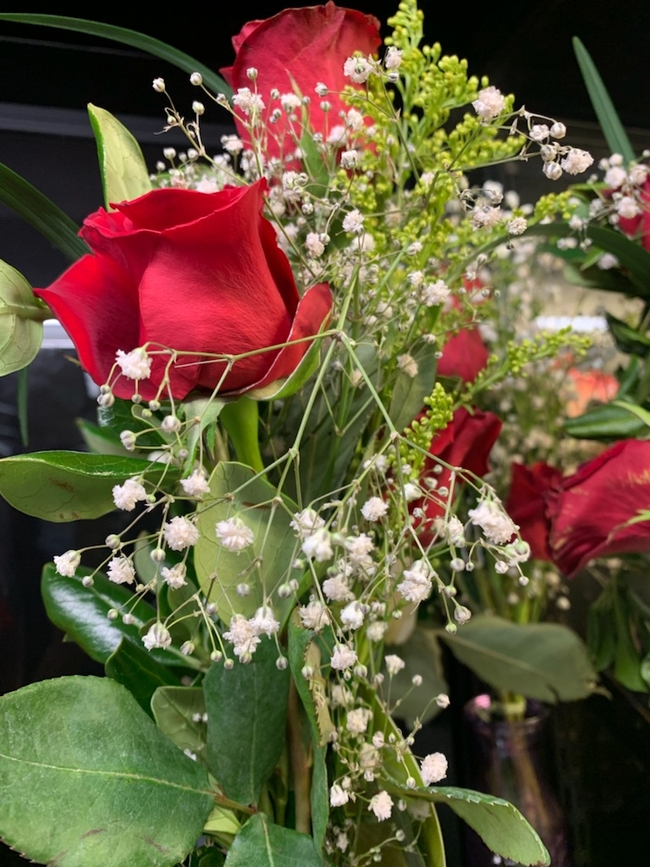
Traditionally:
- red roses: love
- pink roses: complete happiness
- daffodils: regard
- daisies: loyalty
- gardenia: clandestine or secret love.
Flowers express traits of character, as well.
Here are some additional plants aptly named for feelings often accompanying Valentine's Day sentiments: "Bleeding Heart" (Dicentra Spectabilis),"Love in Winter" (Chimaphila umbellata), "Kiss Me Over the Garden Gate" (Persicaria orientale), and "Love Lies Bleeding" (Amaranthus caudatus). Some, such as "Cupid Dart" (Catananche caerulea) were used in potions and other concoctions, in this case by ancient Greeks. And alas, the "All American Roses" of the year for 1980 were “Love”, “Honor” and “Cherish”.
While you're reaching out to your significant others this Valentine's Day (or any day!) make memories last longer by adding the floral preservative that comes with most arrangements or can be purchased separately.
May your love be everlasting........
Janet
- Author: Janet Hartin
Many previously “welcomed” urban tree species have outlived their stay, becoming invasive and crowding out other plants in our Southern California landscapes. You can help by avoiding planting these trees identified by various sources (including the California Invasive Plant Council) to be too aggressive and habitat/resource-depleting for further planting.
Invasive Trees to Avoid Planting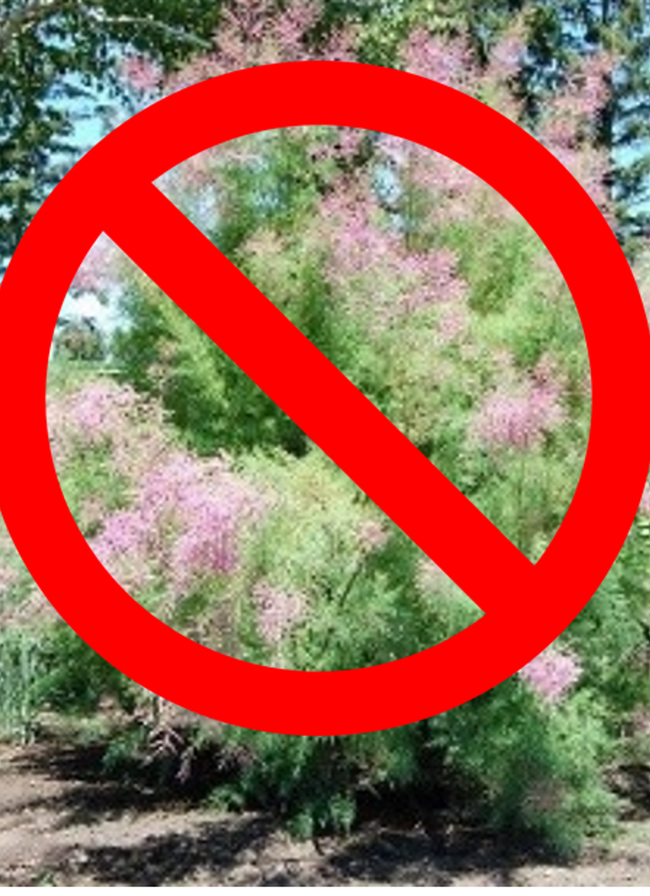
Athel (Tamarix aphylla)
Black Locust (Robinia pseudoacacia)
Blackwood Acacia (Acacia melanoxylon)
Brazilian Pepper (Schinus terebinthifolius)
Chinaberry (Melia azedarach)
Chinese Tallow Tree (Triadica sebifera)
English Hawthorn (Crataegus monogyna)
Peruvian Pepper Tree (Schinus molle)
Red Gum (Eucalyptus camaldulensis)
Russian Olive (Elaeagnus angustifolia)
Saltcedar (Tamarix ramosissima, T. gallica, T. chinensis)
Silver Wattle (Acacia dealbata)
Smallflower Tamarisk (Tamarix parviflora)
Tasmanian Bluegum (Eucalyptus globulus)
Plant These Instead
They are drought/heat resistant, low maintenance, and have no known significant pest or disease problems and are not currently overplanted). Find other suggestions here: https://www.cal-ipc.org/solutions/prevention/landscaping/dpp/?region=socal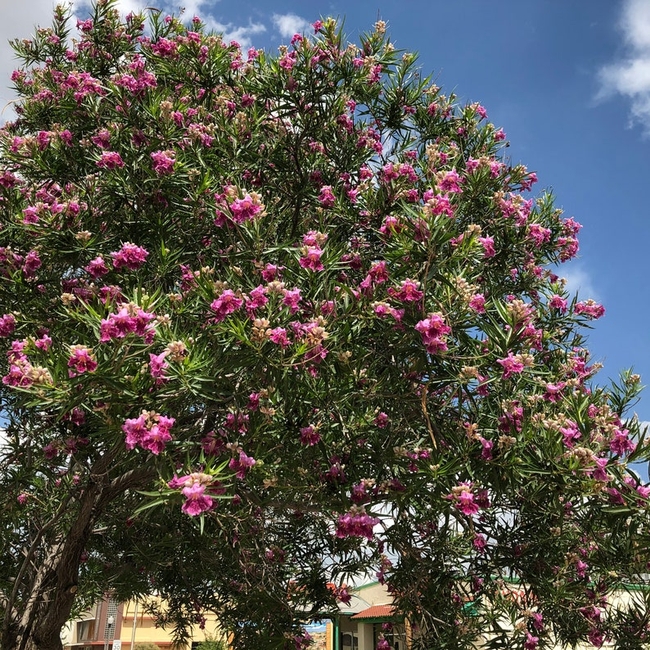
African Fern Pine (Afrocarpus falcatus) (formerly Podocarpus elatior)
Cascolote (Caesalpinia cacalaco Smoothie®)
Desert Willow ‘Bubba' (Chilopsis linearis)
Fringe Tree (Chionanthus virginicus)
Island Oak (Quercus tomentella)
‘Maverick' Mesquite (Prosopis glandulosa)
Mulga (Acacia aneura)
Netleaf Hackberry (Celtis reticulata)
Pink Chitalpa (x Chitalpa tashkentensis 'Pink Dawn')
‘Red Push' Pistache (Pistacia x ‘Red Push')
Thornless South American Mesquite (Prosopis x Phoenix)
- Author: Janet Hartin
Benefits of Plants to People, Communities and Urban Ecosystems: Part 1:
The link between horticulture and health and well-being and to urban ecosystems has been scientifically documented for centuries. In 1812, psychiatrist, professor, and Declaration of Independence signer Dr. Benjamin Rush reported in his book “Medical Inquiries and Observations, Upon the Diseases of the Mind” (Rush 1812) that patients “digging in the dirt”
Benefits related to cognitive functioning, societal and community health, and mental health are summarized below. Ecosystem and physical health benefits from interacting with nature will be discussed in next month's blog.
Improved Cognitive Functioning
Several studies link participation in gardening activities to enhanced cognitive functioning (Bratman et al. 2012; Dadvand et al. 2015; Kuo et al. 2021; Ohly et al. 2016; Park et al. 2019; Stevenson et al. 2018; Wells 2000. Research conducted by Kuo and Sullivan (2001) and Mayer et al. (2009) found that exposure to nature in urban settings can enhance attention span, working memory, and concentration. Both youth and adults who participate in greening and gardening projects were also found to have higher cognitive functioning in the areas of short and long term memory, focus and concentration (Dadvand et al. 2015; Markevych et al. 2019; Matsuoka 2010; Meuwese et al. 2021; Park et al. 2019; Stevenson et al. 2018) and reduced symptoms of ADHD (Faber Taylor and Kuo (2011).
Other studies summarized in a literature review (Williams and Dixon 2013) found that kindergarten and middle school students who participated in school gardening activities linked to classroom learning in biology, nutrition, mathematics, and other subjects earned higher grades and attained greater academic achievement than non-participants. A recent study linked high tree canopy coverage on school grounds with higher achievement scores in math and reading in middle school students across a wide range of socioeconomic and ethnic backgrounds (Kuo et al. 2021). The experiential (hands-on) learning elements of school gardens can also bridge the gap between traditional and non-traditional learners due to its multi-sensory nature (Kolb and Kolb 2005). School gardens play an especially important academic role among elementary-aged youth from low-wealth inner city communities exposed to outdoor experiential learning that was previously lacking (Dyg et al. 2020; Kuo et al. 2021; Ray et al. 2016; Williams et al. 2013). However, Hoover et al. (2021) found that successful, sustainable school gardens require strong administrative and district support in addition to enthusiasm and support from parents and teachers.
Enhancement of Societal and Community Health
Urban greening projects that remediate vacant land, landscape streets and neighborhoods, create community gardens, and improve the health of wetlands and undeveloped natural environments can build community cohesiveness, neighborhood bonding, and mutual community pride (Diamant and Waterhouse 2010; Draper 2010; Glover et al. 2005; Hartwig and Mason 2016; Kuo and Sullivan 2001; Moyer et al. 2019; Neo and Chua 2017; Saldivar-Tanaka and Krasny 2004). With blighted uncared-for vacant lots comprising nearly 15% of total land area of U.S. cities (Branas et al. 2018) these opportunities are substantial. Results also indicate that gardening and urban greening projects unite people from different cultural and ethnic backgrounds who enjoy growing and sharing produce from their native regions (Agustina and Beilin 2012; Baker 2004; Cruz-Piedrahita et al. 2020; Dyg et al. 2016; Hartwig and Mason 2016; Teig 2009). Building a sense of community through social engagement, celebrations, and communal meals has also been found to benefit both gardeners and non-gardener participants (Ober et al. 2008).
Well-designed and maintained urban green spaces not only bring people together, but can reduce crime, gun violence and enhance the safety and cohesiveness of urban neighborhoods, as summarized in several literature reviews (Bogar and Byer 2016: Mancus and Campbell 2018; Shepley et al. 2019). Some of the strongest links reported in the literature involve crime reduction in vegetated and well maintained urban neighborhoods and walkways (Branas et al. 2018; Demotto 2006; Garvin et al. 2013; Locke et al. 2017) and a reduction in gun violence in neighborhoods with green spaces including trees (Branas et al. 2018; Kondo 2017; Schertz et al. 2021; Wolfe et al. 2012). One study found that community-based greening projects that vegetated vacant lots was an effective strategy to improve neighborhood safety, resulting in a nearly 40% decrease in violent crime (Heinze et al. 2018). It should be noted that other researchers (Groff and McCord 2012) found a higher incidence of opportunistic crime in high tree canopy covered areas, perhaps due to concealed illegal activities. Another study found that actively participating in community greening projects from design through implementation and maintenance can result in a sense of accomplishment and satisfaction (Murphy-Dunning 2009). Neighbors caring for urban green spaces together also tend to spend more time conversing and building important social relationships than do non-participants (Peters et al. 2010).
Improved Mental Health
Multiple literature reviews link interactions with nature to improved mental health in both youth and adults (Bowler et al. 2010; Clatworthy et al. 2013; Coventry et al. 2021; Cruz-Piedrahita et. al. 2020; De Vries et al. 2003; Tillmann et al. 2018) in studies conducted in parks, gardens, urban green spaces, and even shopping malls. The restorative impact of simply viewing plants has also been widely studied. Walking through a park and even viewing a natural scene through a window can lead to a sense of well-being, restfulness, reflection, and reduced mental fatigue (Shanahan et al. 2019). More recently, Dzhambov et al. (2020) found lower rates of depression in students homebound for long periods of time during the COVID-19 pandemic with views of plants (indoors and out) compared to students who lacked plant interactions. Bowler's (2010) literature review also highlighted strong associations for self-reported positive emotions and lower levels of anger and sadness in natural settings compared to non-natural settings. Interactions with nature can also reduce symptoms of depression and anxiety (Beyer et al. 2014; Gonzalez et al. 2010; Lee and Maheswaran 2011; Van den Berg and Custers 2011; Wilson and Christensen (2011).
Thompson Coon et al. (2011) reported that exercising outdoors in natural settings led to greater feelings of positivity and revitalization, less tension, anger, and depression compared to the same amount of exercise indoors. Other studies link gardening to feelings of peace and contentment (Meuwese et al. 2021; Shanahan et al. 2015; Shanahan et al. 2019). MacKerron and Mourato (2013) reported that individuals who interact with nature are often happier than those lacking this interaction and Ambrose et al. (2020) reported that home gardeners growing food crops experienced particularly high levels of happiness and meaningfulness. Bakolis et al. (2018) linked two elements of mental well-being (optimism and energy) to interactions with nature while Van den Berg and Clusters (2011) and Wood et al. (2016) found a link between engagement with nature and a reduction in stress. While White et al. (2019) determined that these benefits are maximized when individuals spend 120 minutes a week or more interacting with nature, shorter periods of exposure are also beneficial (Shanahan et al. 2016; Shanahan et al. 2019; White et al. 2019).
Other studies reported a link between growing food and a deepened sense of purpose (Tzoulas 2007; Wiesinger 2006). Digging in the soil can be a welcome distraction from busy lives laden with deadlines, traffic jams, and other everyday stressors. Focusing on the needs of plants, whether it be watering, fertilizing, harvesting or other tasks, can prove pleasantly distracting, providing time for reflection and even problem resolution (Capaldi et al. 2015; Meuwese et al. 2021; Stevenson et al. 2018). Several research papers report important positive roles that plants play related to mental health as impacts of climate change increase (Cryder et al. 2006; Dillman-Hasso et al. 2021; Doherty 2018; Fernandez et al. 2015) related to posttraumatic stress disorder (PTSD), major depressive disorder, stress, anxiety and others.
Literature Cited
Agustina I and Beilin R. 2012. Community gardens: Space for interactions and adaptations, Procedia - Social and Behavioral Sciences. 36:439-448. https://doi.org/10.1016/j.sbspro.2012.03.048
Ambrose G, Das K, Fan Y, Ramaswami A. 2020. Is gardening associated with greater happiness of urban residents? A multi-activity, dynamic assessment in the Twin-Cities region, USA, Landscape and Urban Planning,198(2020). https://doi.org/10.1016/j.landurbplan.2020.103776
Baker LE. 2004. Tending cultural landscapes and food citizenship in Toronto's community gardens. Geographical Review, 94(3):305-325. https://doi.org/10.1111/j.1931-0846.2004.tb00175.x
Bakolis I, Hammoud, R, Smythe, M, et al. 2018. Using Smartphone Technologies to Investigate the Impact of Nature on Mental Well-Being in Real Time, BioScience. 68:134–145, https://doi.org/10.1093/biosci/bix149
Beyer KM, Kaltenbach A, Szabo A, et al. 2014. Exposure to neighborhood green space and mental health: evidence from the survey of the health of Wisconsin. Int. J. Environ. Res. Public Health. 11:3453-3472. https://doi.org:10.3390/ijerph110303453
Bogar S. and Beyer K. 2016. Green space, violence, and crime: a systematic review. Trauma, Violence, & Abuse 17(2)160-171. Accessed Sept. 28, 2021 from: http://journals.sagepub.com.proxyau.wrlc.org/doi/pdf/10.1177/1524838015576412
Bowler DE, Buyung-Ali, L, Knight TM, Pullin AS. 2010. Urban greening to cool towns and cities, A systematic review of the empirical evidence. Landscape and Urban Planning, 97(3):147–155. https://doi.org/10.1186/1471-2458-10-456
Branas C, South E, Kondo M, Hohl B, Bourgois P, Wiebe D, MacDonald J. 2018. Citywide cluster randomized trial to restore blighted vacant land and its effects on violence, crime, and fear. Proceedings of the National Academy of Sciences of the United States of America. http://www.pnas.org/content/early/2018/02/20/1718503115
Bratman GN, Hamilton JP, Daily GC. 2012. The impacts of nature experience on human cognitive function and mental health. Ann. N. Y. Acad. Sci. 1249:118–136. https://doi.org:10.1111/j.1749-6632.2011.06400.x
Capaldi CA, Passmore H, Nisbet EK, Zelenski JM, Dopko RL. 2015. Flourishing in nature: A review of the benefits of connecting with nature and its application as a wellbeing intervention. International Journal of Wellbeing, 5(4):1-16. https://doi.org:10.5502/ijw.v5i4.1
Clatworthy J, Hinds J, Camic P. 2013. Gardening as a mental health intervention: a review. Mental Health Review. 18 (4):214-225. https://doi.org:10.1108/MHRJ-02-2013-0007
Coventry PA, Jennifer VE, Brown J, et al. 2021. Nature-based outdoor activities for mental and physical health: Systematic review and meta-analysis. Popul Health.1;16:100934. https://doi.org/10.1016/j.ssmph.2021.100934
Cruz-Piedrahita C, Howe C, de Nazelle A. 2020. Public health benefits from urban horticulture in the global north: A scoping review and framework, Global Transitions 2:246-256 https://doi.org/10.1016/j.glt.2020.10.001
Cryder CH, Kilmer RP, Tedeschi RG, Calhoun LG. 2006. An exploratory study of posttraumatic growth in children following a natural disaster. Am J Orthopsychiatry 76(1):65–69. https://doi.org:doi:10.1037/0002-9432.76.1.65
Dadvand P, Nieuwenhuijsen, MJ, Esnaola M, et al. 2015. Green spaces and cognitive development in primary schoolchildren. Proceedings of the National Academy of Sciences of the United States of America, 112(26):7937–7942. https://doi.org/10.1073/pnas.1503402112
Demotto N, and Davies CP. 2006. A GIS analysis of the relationship between criminal offenses and parks in Kansas City, Kansas. Cartogr. Geogr. Inf. Sci.33:141-157. https://doi.org/10.1559/152304006777681715
De Vries S, Verheij RA, Groenewegen PP, Spreeuwenberg P. 2003. Natural environments-healthy environments? An exploratory analysis of the relationship between greenspace and health. Environment and planning. 35(10):1717–1731. https://doi.org/10.1068/a35111
Diamant E and Waterhouse A. 2010. Gardening and belonging: reflections on how social and therapeutic horticulture may facilitate health, wellbeing and inclusion. Br J Occup Ther.73:84-88. https:doi.org: https://doi.org/10.4276/030802210X12658062793924
Dillman-Hasso N. 2021. The nature buffer: the missing link in climate change and mental health research. J Environ Stud Sci. https://doi.org/10.1007/s13412-021-00669-2
Doherty TJ. 2018. Individual impacts and resilience. In: Clayton S, Manning C (eds) Psychology and Climate Change. Academic Press, pp 245–266. https://doi.org/10.1016/B978-0-12-813130-5.00010-2
Draper C and Freedman D. 2010. Review and Analysis of the Benefits, Purposes, and Motivations Associated with Community Gardening in the United States, Journal of Community Practice. 8(4):458-492. https://doi:10.1080/10705422.2010.519682
Dzhambov AM, Lercher P, Browning MH, et al. 2020. Does greenery experienced indoors and outdoors provide an escape and support mental health during the COVID-19 quarantine? Environmental Research, 110420. https://doi.org/10.1016/j.envres.2020.110420
Dyg P, Christensen S, Peterson C. 2020. Community gardens and wellbeing amongst vulnerable populations: a thematic review, Health Promotion International, Volume 35, Issue 4, August 2020, Pages 790–803, https://doi.org/10.1093/heapro/daz067
Faber Taylor A and Kuo FE. 2011. Could exposure to everyday green spaces help treat ADHD? Evidence from children's play settings. Applied Psychology: Health and Well-Being, 3: 281-303. https://doi.org/10.1111/j.1758-0854.2011.01052.x
Fernandez A, Black J, Jones M, Wilson L, Salvador-Carulla L, Astell-Burt T, Black D. 2015. Flooding and mental health: a systematic mapping review. PLoS One https://doi.org:10(4):e0119929
Garvin EC, Cannuscio CC, Branas CC. 2013. Greening vacant lots to reduce violent crime: A randomised controlled trial. Inj Prev. 19:198–203. https://doi.org:10.1136/injuryprev-2012-040439
Glover TD, Shinew KJ, Parry DC. 2005. Association, sociability, and civic culture: the democratic effect of community gardening. Leis Sci. 2005;27(1):75–92. https://doi.org:10.1080/01490400590886060
Gonzalez MT, Hartig T, Patil GG, Martinsen EW, Kirkevold M. 2010. Therapeutic horticulture in clinical depression: a prospective study of active components. J Adv Nurs. 66:2002-2013. https://doi.org:10.1891/1541-6577.23.4.312
Groff, E and McCord ES. 2012. The role of neighborhood parks as crime generators. Secur. J. 25:1–24, https://doi.org:10.1057/SJ.2011.1
Hartwig, KA and Mason M. 2016. Gardens for refugee and immigrant communities as a means of health promotion. J. Community Health, 41 (6):1153-1159. https://doi.org/10.1007/s10900-016-0195-5
Heinze JE, Krusky-Morey A, Vagi KJ, Reischl TM Franzen S, Pruett NK, Cunningham RM, Zimmerman MA. 2018. Busy streets theory: the effects of community-engaged greening on violence. American journal of community psychology, 62(1-2):101–109. https://doi.org/10.1002/ajcp.12270
Hoover, Amy, Vandyousefi Sarvenaz, Martin Bonnie, et al. 2021. Barriers, Strategies, and Resources to Thriving School Gardens, J Nutr Educ Behav. 53(7):591-601. https://doi.org/10.1016.j.jneb.2021.02.011
Kolb DA and Kolb AY. 2005. Learning styles and learning spaces: Enhancing experiential learning in higher education, Academy of Management Learning and Education, 4(2):193-212. Accessed Sept. 16 2021: http://www.jstor.org/stable/40214287.
Kondo MC, South EC, Branas CC, Richmond TS, Wiebe D.J. 2017. The association between urban tree cover and gun assault: a case-control and case-crossover study. American Journal of Epidemiology 186(3):289-296. https://doi.org:10.1093/aje/kwx096
Kuo M, Klein SE, Browning MH, Zaplatosch J. 2021. Greening for academic achievement: Prioritizing what to plant and where, Landscape and Urban planning, 206(2021). https://doi.org/10.1016/j.landurbplan.2020.103962
Kuo F.E.; Sullivan W.C. 2001. Environment and Crime in the Inner City—Does Vegetation Reduce Crime? Environ. Behav. 33(343). https://doi.org:10.1177/0013916501333002
Lee, ACK and Maheswaran, R. 2011. The health benefits of urban green spaces: a review of the evidence. Journal of Public Health, 33(2), 212-222. https://doi.org/10.1093/pubmed/fdq068
Locke DH, Han S, Kondo MC, Murphy-Dunning C, Cox M. 2017. Did community greening reduce crime? Evidence from New Haven, CT, 1996–2007. Landsc. Urban Plan. 2017;161:72–79. https://doi.org:10.1016/j.landurbplan.2017.01.006
MacKerron G and Mourato S. 2013. Happiness is greater in natural environments. Global Environmental Change. 23(5):992-1000. https://doi.org/10.1016/j.gloenvcha.2013.03.010
Mancus GC and Campbell J. 2018. Integrative review of the intersection of green space and neighborhood violence. J. Nurs. Scholarsh. 50:117–125. https://doi.org:10.1111/jnu.12365
Markevych, I. Feng, X. Astell-Burt T. Standl M. Sugiri D. Schikowski, et al. 2019. Residential and school greenspace and academic performance: Evidence from the GINIplus and LISA longitudinal studies of German adolescents. Environ. Pollut. 245:71-76. https://doi.org/10.1016/j.envpol.2018.10.053
Matsuoka RH. 2010. Student performance and high school landscapes: Examining the links. Landsc. Urban Plan. 97:273-282. https://doi.org/10.1016/j.landurbplan.2010.06.011
Mayer FS, Frantz CM, Bruehlman-Senecal E, Dolliver K. 2009. Why Is Nature Beneficial? The Role of Connectedness to Nature. Environment and Behavior.41(5):607-643. https://doi.org:10.1177/0013916508319745
Meuwese D, Maas J, Krabbendam L, Dijkstra K. 2021. Viewing Nature Lets Your Mind Run Free: Three Experiments about the Influence of Viewing a Nature Video on Cognitive Coping with Psychological Distress. Int J Environ Res Public Health. 22;18(16):8842. https://doi.org:10.3390/ijerph18168842
Moyer R, MacDonald JM, Ridgeway G, Branas CC. 2019. Effect of remediating blighted vacant land on shootings: a citywide cluster randomized trial. Am. J. Public Health.109:140–144. https://doi.org/10.2105/AJPH.2018.304752
Neo H and Chua CY. 2017. Beyond inclusion and exclusion: community gardens as spaces of responsibility. Ann. Am. Assoc. Geogr. 107(3):666-681. https://doi.org:10.1080/24694452.2016.1261687
Ober J, et al. 2008. Growing vegetables and values: benefits of neighborhood-based community gardens for youth development and nutrition, Journal of Hunger & Environmental Nutrition 3(4):418-439, https://doi.org:10.1080/19320240802529169
Ohly H, White MP, Wheeler BW, et al. 2016. Attention restoration theory: A systematic review of the attention restoration potential of exposure to natural environments. Journal of Toxicology and Environmental Health, Part B, 19 (7):305-343, https://doi.org:10.1080/10937404.2016.1196155
Park, SA, Lee AY, Park H, Lee WL. 2019. Benefits of Gardening Activities for Cognitive Function According to Measurement of Brain Nerve Growth Factor Levels. International journal of environmental research and public health, 16(5):760. https://doi.org/10.3390/ijerph16050760
Ray R, Fisher DR, Fisher-Maltese C. 2016. School gardens in the city. Does environmental equity help close the achievement gap?. Du Bois Review: Social Science Research on Race, 13(2):379-395. Accessed Sept. 15, 2021 from: http://dx.doi.org/10.1017/S1742058X16000229
Rush B. Medical inquiries and observations upon diseases of the mind. Philadelphia: Kimber & Richardson; 1812. [Accessed August 28, 2010]. p. 226. Available at: http://deila.dickinson.edu/theirownwords/title/0034.htm
Saldivar-Tanaka L and Krasny ME. 2004. Culturing community development, neighborhood open space, and civic agriculture: the case of Latino community gardens in New York City. Agric. Hum. Val., 21 (4):399-412. https://doi.org/10.1023/B:AHUM.0000047207.57128.a5
Schertz KE, Saxon J, Cardenas-Iniguez C, et al. 2021. Neighborhood street activity and greenspace usage uniquely contribute to predicting crime. npj Urban Sustain.1(19). https://doi.org/10.1038/s42949-020-00005-7
Shanahan DF, Astell-Burt T, Barber EA, Brymer E, et al. 2019. Nature-based interventions for improving health and wellbeing: the purpose, the people and the outcomes. Sports (Basel)10;7(6):141. http://doi.org:10.3390/sports7060141
Shanahan DF, Fuller RA, Bush R, Lin BB, Gaston KJ. 2015. The health benefits of urban nature: how much do we need? BioScience 65(5):476–485. https://doi.org/10.1093/biosci/biv032
Shepley M, Sachs N, Sadatsafavi H, Fournier C, Peditto K. 2019. The impact of green space on violent crime in urban environments: An evidence synthesis. Int. J Environ Res Public Health. 2019;16(24):5119. https://doi.org:10.3390/ijerph16245119
Stevenson MP, Schilhab T, Bentsen P. 2018. Attention restoration theory II: A systematic review to clarify attention processes affected by exposure to natural environments Journal of Toxicology and Environmental Health, Part B, 21(4):227-268. https://doi.org:10.1080/10937404.2018.1505571
Teig E, Amulya J, Bardwell L, et al. 2009. Collective efficacy in Denver, Colorado: Strengthening neighborhoods and health through community gardens. Health & Place, 15(4): 1115-1122. https://doi.org/10.1016/j.healthplace.2009.06.003
Thompson Coon J, Boddy K, Stein R, et al. 2011. Does participating in physical activity in outdoor natural environments have a greater effect on physical and mental wellbeing than physical activity indoors? A systematic review. https://doi.org:10.1021/es102947t
Tillmann S, Tobin D, Avison W, Gilliland J. 2018. Mental health benefits of interactions with nature in children and teenagers: a systematic review. J Epidemiol. Community Health 72(10):958–966. https://doi.org:10.1136/jech-2018-210436
Tzoulas K, Korpela K, Venn S. 2007. Promoting ecosystem and human health in urban areas using green infrastructure: a literature review. Landsc. Urban Plan. 2007;81:167–178. https://doi.org/10.1016/j.landurbplan.2007.02.001
Van den Berg AE and Custers MH. 2011. Gardening promotes neuroendocrine and affective restoration from stress. J. Health Psychol.16:3–11https://doi.org/10.1177/1359105310365577
Wiesinger G, Neuhauser F, Putz M. 2006. Farming for health in Austrian Farms, horticultural therapy, animal-assisted therapy. In: Hassink J., Dijk M., editors. Farming for health: Green-Care farming across Europe and the United States of America. Springer; Dordrecht, The Netherlands, pp. 233–248. Wells, NM. 2000. At home with nature: Effects of “greenness” on children's cognitive functioning. Environ. Behav.32(6):775–795. https://doi.org:10.1177/00139160021972793
White MP, Alcock I, Grellier J. et al. 2019. Spending at least 120 minutes a week in nature is associated with good health and wellbeing. Sci Rep 9(7730). https://doi.org/10.1038/s41598-019-44097-3
Wilson JF and Christensen KM. 2011. The relationship between gardening and depression among individuals with disabilities. J. Ther. Hortic. 2011;21:28–41.
Williams DR, Dixon PS. 2013. Impact of Garden-Based Learning on Academic Outcomes in Schools: Synthesis of Research Between 1990 and 2010. Review of Educational Research. 2013;83(2):211-235. http://doi.org:10.3102/0034654313475824
Wolfe MK, Mennis J, Mennis J. 2012. Does vegetation encourage or suppress urban crime? Evidence from Philadelphia, PA. Landsc Urban Plan.108(2-4):112–122. https://doi.org:10.1016/j.landurplan.2012.08.006
Wood C.J., Pretty J., Griffin M. 2016. A case–control study of the health and well-being benefits of allotment gardening. J. Public Health. 38:336–e344. https://doi.org/10.1093/pubmed/fdv146
Wolch, J, Byrne, J Newell, J. 2014. Urban green space, public health, and environmental justice: The challenge of making cities `just green enough'. 125:234-244. https://doi.org10.1016/j.landurbplan.2014.01.017
- Author: Janet Hartin
“To forget how to dig the earth and to tend the soil is to forget ourselves.” Mohandas K. Gandhi, World leader, political ethicist, lawyer
“Everything that slows us down and forces patience, everything that sets us back into the slow circles of nature, is a help. Gardening is an instrument of grace. ” May Sarton, Poet “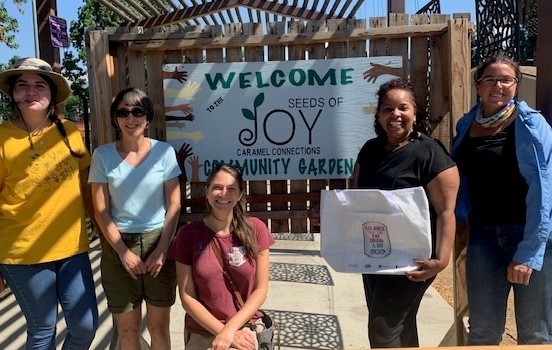
"May our heart's garden of awakening bloom with hundreds of flowers.” Thich Nhat Hanh, global spiritual leader and activist “If you have a garden and a library, you have everything you need.” Marcus Tullius Cicero, Roman philosopher
"The importance of encouraging our children in outdoor work with living plants is now recognized. It benefits the health, broadens the education, and gives a valuable training in industry and thrift. The great garden movement is sweeping over all America, and our present problem is to direct it and make it most profitable to the children in our schools and homes. — Van Evrie Kilpatrick, 1918, in “The Child's Food Garden”
As the above quotes so beautifully proclaim, interacting with nature, whether passively (viewing plants) or actively (gardening, etc.) offers many positive benefits. In fact, the link between horticulture and health and well-being has been scientifically documented for centuries. In 1812, psychiatrist, professor, and Declaration of Independence signer Dr. Benjamin Rush reported that patients participating in gardening activities had better mental health outcomes than non-gardening counterparts.
Many additional papers were published throughout the 1800's documenting benefits of active participation in gardening. More recently, positive links between simply viewing plants through a window or even on a television, movie, or exercise apparatus screen have been reported in peer-review journals. A groundbreaking study in this area was published in 1984 by environmental psychologist Robert Ulrich (Ulrich, 1984) who compared post-operative patients recovering from gall bladder surgery who had views of landscape plants to recovering patients who had the same surgery in the same facility with views of a brick wall. Patients with landscape views had fewer surgical complications, shorter hospital stays, required fewer analgesics, had better moods, and even fewer derogatory remarks by medical staff in their daily records.
Since 1984, dozens of other studies have documented similar positive outcomes resulting from both passive and active engagement with nature and plants. These include improved physical, mental and emotional health; environmental benefits; and community and societal benefits. Recent literature reviews that summarize these findings include:
- An overview of 77 peer-reviewed journal articles (Howarth, et. al., 2020) identified 35 positive outcomes linking physical and mental health and well-being to active and passive horticultural interactions. doi: https://10.1136/bmjopen-2020-036923
-A meta-analysis (Soga, 2016) of 22 studies identified several positive mental health outcomes related to gardening including mood, group cohesiveness, cooperation, pride, well-being, and more. https://doi.org/10.1016/j.pmedr.2016.11.007 -
An overview of 45 peer-review studies (Shepley, et. al., 2019) identified links between properly designed and maintained urban green spaces and crime, gun violence, and the overall safety and cohesiveness of low-wealth urban neighborhoods. https://doi.org/10.3390/ijerph16245119
- A review of 120 papers (Crus-Piedrahita, et. al., 2020) reported public health benefits from urban horticulture activities in the global North. Thirty-two papers had a specific focus on social cohesion and/or social capital. https://doi:10.1016/j.glt.2020.10.001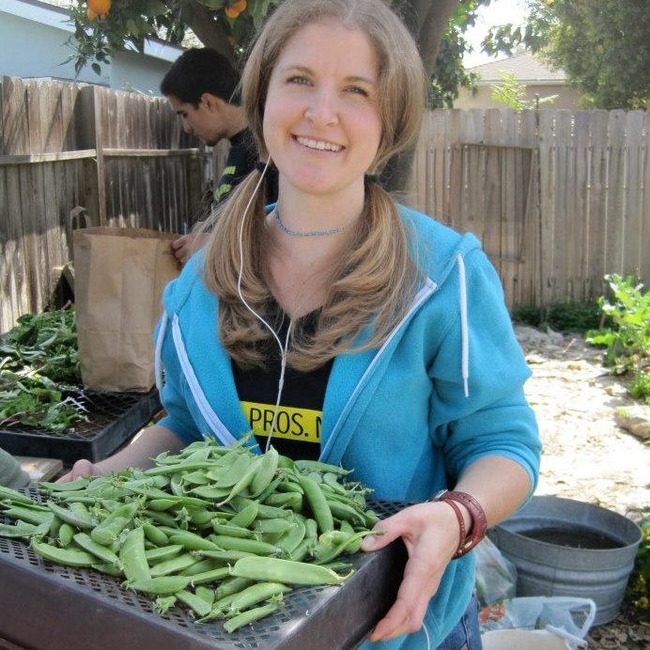
-Alizadeh (2019) synthesized research regarding the environmental benefits of urban plants, highlighting their vital roles in combating climate change, cooling urban heat islands, providing habitat, removing air and water pollutants, enhancing soil health, and more. https://www.researchgate.net/deref/https%3A%2F%2Fdoi.org%2F10.1108%2FIJCCSM-10-2017-0179
Enjoy your garden! Enjoy a day in nature.

